Waterproof acceptance meaning

As far as the family is concerned, waterproofing mainly includes kitchens, bathrooms, balconies, terraces, and easily damp walls. Problems such as leakage and mildew caused by improper waterproofing will seriously affect life, and many families suffer from it. In recent years, with the continuous improvement of people's living standards and living quality, home waterproofing has become more and more important. The variety of waterproof materials and the uneven construction technology, the selection of waterproof materials and waterproofing technology is still a major problem for many families.
Waterproof acceptance process
1. A 15 cm high retaining wall is to be built in the room to be checked and accepted;
2. Put 10 centimeters of water in the room, and at the same time, make a good mark on the surface of the water.
3. After 24 hours, observe whether the height of the water surface has changed, and check whether the ceiling of the room at the same position in the downstairs has water seepage;
4, if the above phenomenon does not appear, you can think that waterproof construction acceptance; otherwise, if the inspection found the above phenomenon, you can think that waterproof construction failed. If the acceptance is unqualified, the waterproof project must be reworked and re-inspected; for the acceptance of the light-weight wall waterproof construction, the water-drenching test shall be adopted, even if the water pipe is on top of the waterproof paint wall. Discontinuity spray for 3 minutes. After 4 hours, observe whether the other side of the wall will have a seepage phenomenon. If there is no penetration phenomenon, it can be considered that the wall waterproof construction is qualified.
Waterproof acceptance considerations
Closed water test: After the water retaining wall is completed, water shall be stored in the space to be tested to check for leakage. Waterproof layer construction more common in the kitchen, bathroom. In the acceptance test, the water-rejection test must be done and the surface layer can be done only after the parties A and B determine that the test result is acceptable. If you do not do a water-retaining test or if the test fails, you will make a surface layer. In the event of a leak, only the surface layer will be removed and you will start again.
Put a 30-50 high-millimeter retaining bar (can) on the doorway of a room with a waterproof layer, using yellow muddy soil, low-grade cement mortar, and other materials, and close the floor drains tightly. Water is poured into the ground to form a small pool with a depth of 20 to 30 mm. 2 After 24 hours of water storage and storage, together with the property department and the corresponding neighbors in the bathroom downstairs, they will jointly inspect whether or not the floor is leaking. Jointly signed and accepted. If there is any leakage, re-do or repair the waterproof layer, and then close the water test in the above order. Until no leakage qualified.
Drenching test: For the acceptance of light-weight wall waterproofing construction, a watering test shall be adopted, even if the water pipe is sprayed on the wall of the waterproof paint continuously for 3 seconds from top to bottom, and the wall is observed after 4 hours. Whether or not the other side will see the phenomenon of infiltration, if there is no penetration phenomenon, it can be considered that the wall waterproof construction acceptance.
First, closed water test is essential
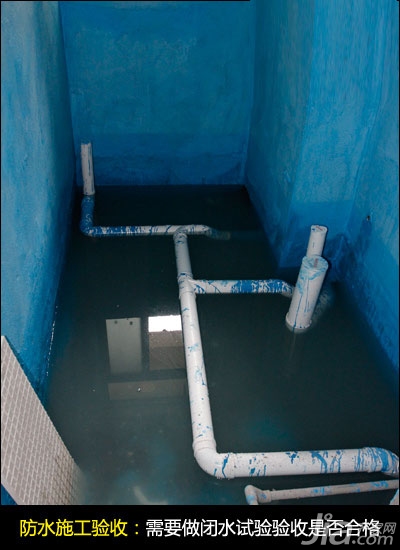
Closed water test is an important work of waterproof inspection. For the original waterproof layer, through the closed water test, we can understand whether the waterproof layer is in good condition, whether it needs to be repaired, and whether it is necessary to redo the waterproof layer. For the new waterproof layer can be used to check the waterproof construction is qualified.
Second, the general practice of closed water test
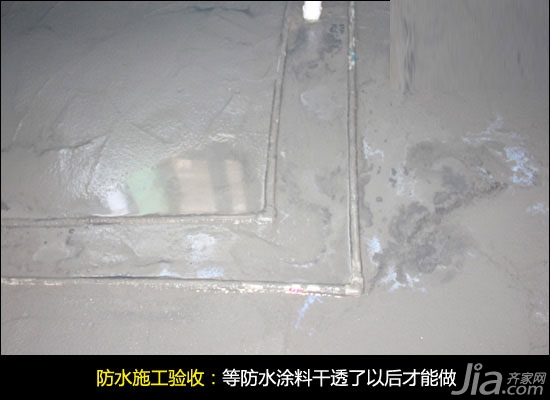
The closed water test must be completed after the waterproof coating dries out. First, put the prepared sand in a plastic bag to block the floor drain tightly to prevent the stored water from running off; then, the water may fill the doorway. Plug the cement; then put the water, the water to wet the entire surface of the painted water test should all be soaked, generally put 10cm is enough, if the fear of release of water evaporated in the next 48 hours, generally put 20cm.
Third, the closed water test standard
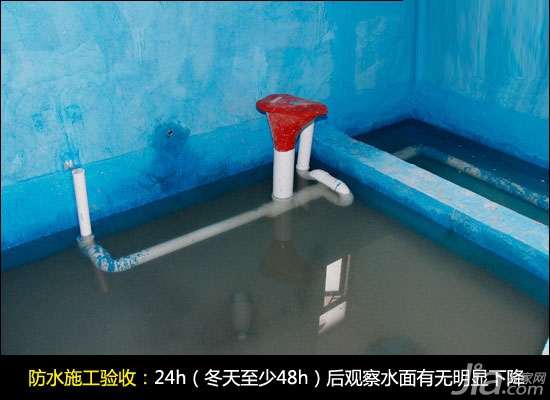
The closed water test time is at least 24 hours in summer and at least 48 hours in winter. During this period of time, it is observed whether there is a significant drop in water level, especially if there is any leakage in the roof of the house downstairs to check whether the waterproof construction is qualified. The light wall shall be used for the watering test. The water pipe shall be sprayed continuously on the wall from top to bottom for 3 minutes. After 4 hours, the penetration of the other side of the wall will be observed. If there is no penetration, the waterproof construction acceptance shall be considered. qualified.
Fourth, closed water test operation details
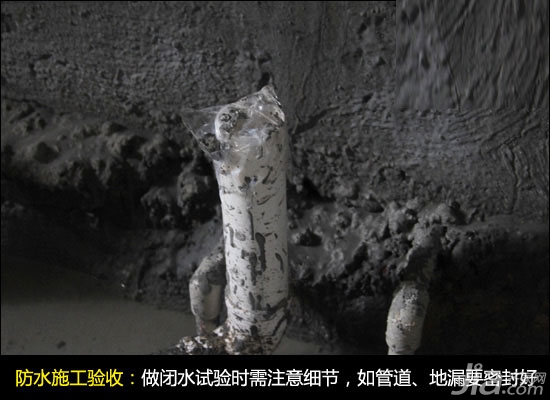
The following points should be noticed when making a water-retaining test: First, the floor drain must be plugged tightly, and if the topography is to block cement at the entrance, it must wait for the cement to dry before releasing the water; secondly, when the water is drained, the water column directly touches the ground. Pots or lids and the like prevent the water pressure from breaking the waterproof layer too strongly.
Fifth, closed water treatment methods
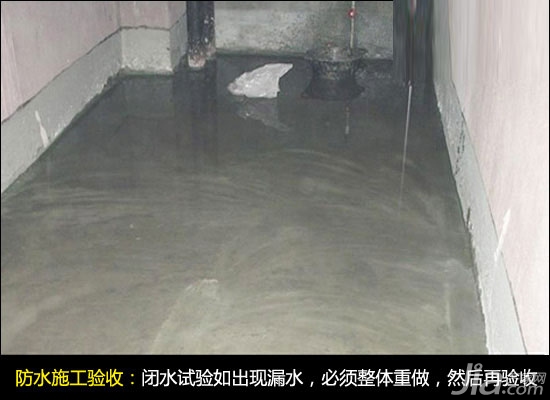
If the closed water test is not closed, the waterproofing project must be reworked as a whole and the inspection must be re-accepted. Only after passing the acceptance can other construction be carried out.
Six, to understand the warranty period of housing waterproofing
General housing waterproofing is carried out by the decoration company. According to Article 32 of the “House Interior Decoration Management Regulationsâ€, under the normal conditions of use, the minimum warranty period for residential interior decoration works is two years, and there is a kitchen with waterproof requirements. Bathrooms and external walls and prevent leakage for five years. Therefore, if the house leaks within 5 years, you can find a decoration company to ask for responsibility.
1. Waterproof construction should be used for coating waterproof material.
2. The performance of waterproof material shall comply with the relevant national standards and shall have a product certificate of conformity.
3. The surface of the grass-roots level should be flat and there must be no defects such as emptying, sanding, cracking, etc. The base layer moisture content should meet the construction requirements for waterproof materials. The waterproof layer should extend from the ground to the wall, 250mm above the ground. The height of the waterproof layer on the bathroom wall should not be less than 1800mm.
4. Waterproof cement mortar leveling layer and the foundation are combined densely, without empty drums, the surface smooth and smooth, no cracks, sand, yin and yang angle made into a rounded shape.
5 coating film waterproof layer brushing uniform, thickness to meet the requirements of product specifications, the general thickness of not less than 1.5mm not exposed.
6. The use of construction joints should be lapped in the direction of the flowing water. The lap width should not be less than 100mm. When using two or more layers of glass fiber cloth to overlap one another, one-half of the width should be opened.
7. The surface of the coating film is not blistering, flowing, flat and without bumps, and the joints of pipe fittings, sanitary fittings, floor drains, and drain outlets are tightly closed and do not leak.
8. The thickness and strength of the protective layer cement mortar must meet the design requirements. During the operation, it is strictly prohibited to break the waterproof layer. According to the design requirements, the surface float slope should be completed, the drainage should be smooth, and there should be no backwater slope phenomenon.
9. After the completion of the waterproofing project, the 24-hour closed water test must be performed.
The main preparation for this step
1. In advance with the foreman and tile masters must be closed to do water test, especially the kitchen. Some kitchens have put on a wall tile during the water-retention test. The reason is that the tile-laying master thinks that there is no need to close the water in the kitchen (as many masters still think that the kitchen does not need to be waterproof, but some kitchens often have leaks downstairs, so it is still necessary to do something ).
2. Before we can explain the closed water test to the foreman and tile master in advance, we must notify the owner in advance. The reason is that we can contact the neighbors downstairs. For example, when my family first made waterproof work, the worker’s master did not tell me, and when I arrived, I went downstairs to find my neighbor. When the neighbor was not at home, I asked other neighbors to know that their family was on vacation. It will only return after months.
3. It is recommended that when you start the water-blocking test, you will go to the neighbor's house downstairs two hours later. The reason is that there is a problem with the closure of water. If there is leakage, it will not cause great damage to the neighbors. If there is no problem, it will be watched again after 24 hours.
Decoration waterproof entrance decoration restaurant decoration cement room home decoration house paint decoration look decoration company okay kitchen wall tile bathroom door bathroom wall tile bathroom waterproof material overall bathroom bathroom design bathroom waterproof bathroom leaking water and electricity phase
Ungrouped,High Quality Ungrouped,Ungrouped Details, CN
JINING USP INTERNATIONAL CO.,LTD. , https://www.uspintl.com